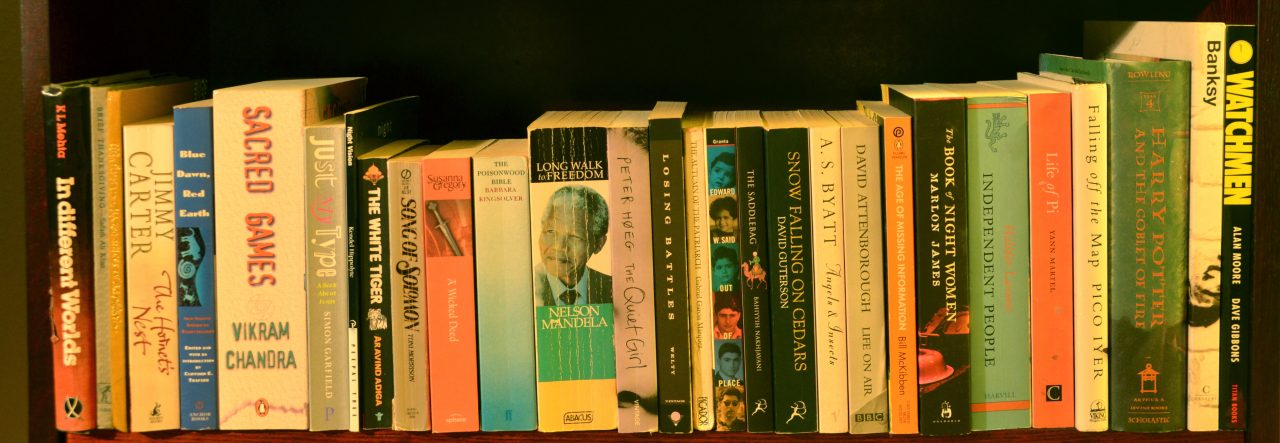Published by Vintage, 2018, 625 pages.
“A man in the boreal north lies on his back on the cold ground at dawn. … [T]he spruces pour out messages in media of their own invention. They speak through their needles, trunks, and roots. They record in their own bodies the history of every crisis they’ve lived through. The man…lies bathed in signals hundreds of millions of years older than his crude senses.”
Recent research has shown that trees are much more sentient than we had previously thought.[1] They communicate with and take care of each other, and defend themselves when attacked. They are an intrinsic part of our lives and our well-being in so many ways. And we are cutting them down at an alarming rate: since 1990, we have lost 420 million hectares of forest.[2]
The Overstory is an impassioned plea to preserve our trees and forests. Richard Powers tells the story through the lives of nine Americans, who are all from very different backgrounds. But the one thing they do have in common is that when they were children, almost all of them had a connection with trees.
The book is divided into four sections: Roots, Trunk, Crown and Seeds. Roots describes the backstories of the nine people. Trunk brings them together in battling deforestation. Crown visits them 20 years later, and Seeds is the book’s epilogue.
Nicholas Hoel has inherited photographs of a chestnut tree on his parents’ farm in Iowa. This tree survived the blight which killed every other chestnut tree in the area. The photographs were taken by Nicolas’s father once a month, year after year.
Olivia Vandergriff is a hard-partying student who dies for a minute and ten seconds when she electrocutes herself by mistake. She emerges from the experience with memories of creatures of light sending her back into the world for a purpose.
Mimi Ma’s father left China for the US, bringing with him three jade rings engraved with trees and an ancient scroll. After his suicide, the rings are divided among his three daughters. Mimi gets the one with the “thin trunk of things to come”.
Douglas Pavlicek is an army pilot who is saved by falling into a banyan tree when his plane crashes. He and Mimi meet when they protest the felling of trees near her office, and he persuades her to join him in an anti-deforestation movement.
Neelay Mehta is the son of Indian immigrants who is paralysed as a child when he falls out of a tree. He becomes a coder who creates a video game that echoes the earth—“a living, breathing, seething animist world filled with millions of different species, a world desperately in need of the players’ help.”
Ray Brinkman and Dorothy Cazaly are a couple whose marriage is dissolving when Ray has a stroke that leaves him incapacitated. But they come together by studying the trees in their backyard. The other characters include Adam Appich, a psychologist; and Patricia Westerford, a hearing-impaired researcher who is mocked when she writes on how trees communicate with each other.
Nicholas, Olivia, Mimi, Douglas and Adam head to California to prevent the logging of ancient redwoods. To stop this, Nicholas and Olivia climb into the tops of one of these giants and live there for a while, defying the loggers. The description of how they spend months camped up high in the tree is one of my favourite parts of the book: the way they slowly adapt to living hundreds of feet above the known world. The tree becomes as much a character as the two humans.
This book is quite an achievement: I loved the fact that all nine people are so different. But the trees are at the centre of this book: they are the driving force that propels the plot. By intertwining the lives of people and trees, Powers makes us see how deeply interconnected we are. “You and the tree in your backyard come from a common ancestor. A billion and a half years ago, the two of you parted ways. But even now, after an immense journey in separate directions, that tree and you still share a quarter of your genes.”
Like trees, The Overstory takes time to grow, setting the stage and then pulling together the disparate threads of the first section into a woven whole. I found the first section long—it reads like a series of unconnected character sketches. However, the book comes together in the following section, with each one of the characters playing a key role.
This is not just a novel, it is also a warning of how we are destroying our forests and cutting down trees—organisms that are far more complex than we are and that have been on this earth long before us. By destroying them, we destroy our own future.
[1] See the review of The Hidden Life of Trees by Peter Wohlleben.
[2] According to the Food and Agriculture Organization of the United Nations (FAO), The State of the World’s Forests, 2020. https://www.fao.org/state-of-forests/en/.


Pingback: The Hidden Life of Trees: What They Feel, How They Communicate―Discoveries from A Secret World: Peter Wohlleben – Talking About Books
lovely review, Suroor! Its one of my favourite books. I might re-read it this year (after reading your review).
Thanks! Glad you enjoyed the review.
Great review! I am looking forward to reading the book and this review made me more excited.
Thanks! Glad you enjoyed it.
I have not read your review (which I’m sure is excellent) yet because the Overstory is the next book I’m going to read, when I’m finished with Tyll -which I finally found in a second-hand book shop in France!
Did you enjoy Tyll?
I’m currently reading it. (His father’s just been burned). I’m loving every page of the novel!
Glad you’re enjoying it!
Pingback: Best books of 2018 – Talking About Books
Pingback: The Best Books of 2022 – Talking About Books